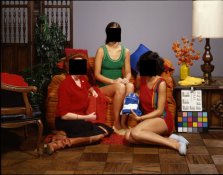I know you're trying to look liberal and enlightened, but by ignoring the observable reality that people from different parts of the world do indeed look different from each other (while looking similar to others from their part of the world) you just end up looking foolish. You're confusing race and species. We are not all the same race, but we are the same species no matter what our race.
Race is more than skin color anyway, it encompasses a number of aspects of physical appearance, like hair color, hair texture, shape of eyes and other facial features. There are medically important biological differences between races too. Some inherited medical conditions only affect people of certain racial groups. Sickle Cell Anemia, for example, is never found among Europeans or Asians. It is a genetic trait found only among Africans from south of the Sahara (blacks).
Instead of trying to lie and claim that races do not exist, you would be better off promoting understanding and tolerance of cultural differences and different appearances. Despite the very real physical differences between different races of mankind, we are all still brothers and sisters.
Anyway, as others have pointed out, this is a technical discussion of how to ensure good rendering of dark skin,which is a real issue. I've seen way too many photos of African American friends whose faces are so dark in the photo that all you see are eyes and teeth, and there's no excuse for such a stupid technical blunder when one can, through correct exposure, ensure that dark skin is rendered beautifully and with full detail.
What a good post Chris, I personally when photographing dark skinned people use a method of assessing the exposure compensation for the skin tone, I take a close up reading of the face and check it against a reading of a Kodak 18% Grey Card in the same position, the difference gives me the amount to compensate for in the exposure.








